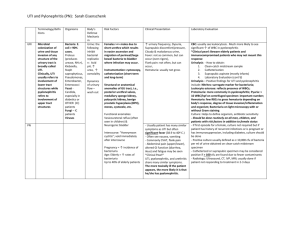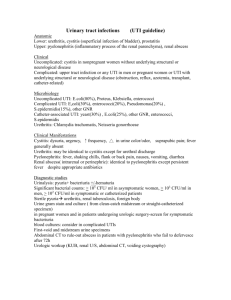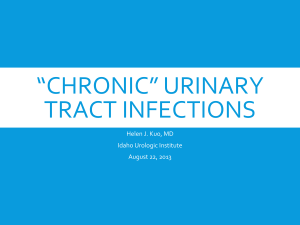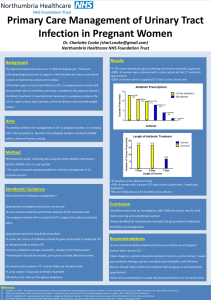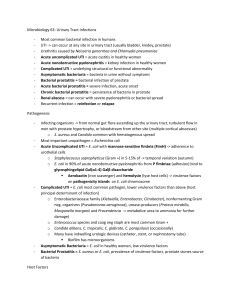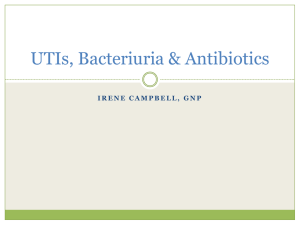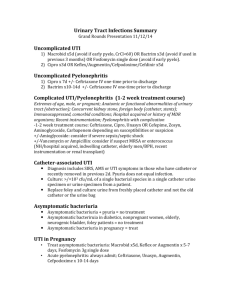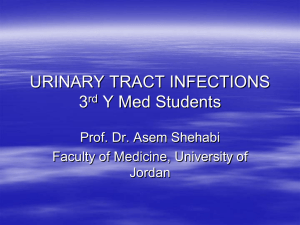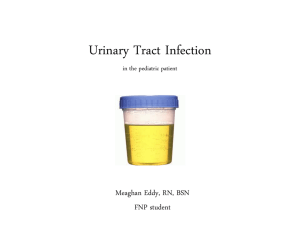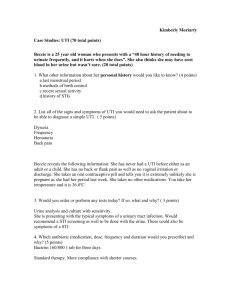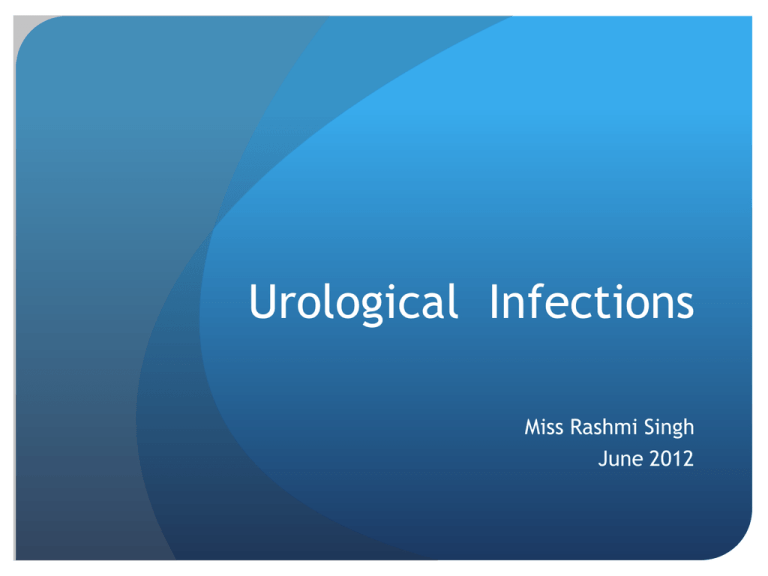
Urological Infections
Miss Rashmi Singh
June 2012
Overview
•
UTI
•
•
•
•
Simple
Complicated
High risk groups
Recurrent
Pyelonephritis
Epididymo-orchitis
Prostatitis
Rarities
UTI’s
•
•
•
•
•
•
15% of all community prescribed abs
100,000 hospital admissions
40% of hospital acquired infections
Distressing for patients
Impact on quality of life
Can be significant cause of morbidity
in the elderly
Acute Uncomplicated Cystitis
•
•
Acute cystitis in otherwise healthy individual
Usually women with no underlying urinary tract
abnormality
70-80% E coli
10-20% other coliforms (serratia, enterobacter, klebsiella,
morganella)
6-7% Enterococci
1% pseudomonas- suspect urological abnormality
1-2% others- group B Strep, staph aureus, staph saprophyticus,
Coag negative staph, Candida
Diagnosis
•
Symptoms
Exclude vaginal discharge/irritation
•
Urine dipstick can be sufficient
•
Urine cultures if:
Suspect acute pyelonephritis
Atypical symptoms
Symptoms persist or recur 2-4 weeks
after treatment
•
>103 colony count microbiologically
diagnostic
Urine dipstick
•
Leucocytes- 75-95% sensitive
False negative –concentrated urine,
glycosuria, ascorbic acid, urobilinogen
False positive- contamination
•
Nitrites- low sensitivity 35-85%
False negative- very common if low
bacterial count
False positive- contamination.
Use in conjunction with urine appearance
•
MSU sensitivity affected by collection
technique, time taken to reach lab,
bacterial count etc
Antibiotic Therapy
•
Clinical success significantly more likely with antibiotics
compared to placebo
•
•
•
•
•
•
•
Local resistance patterns
Efficacy
Tolerability
Adverse effects
Compliance
Cost
Availability.
Local sensitivity patterns
•
“simple” Ecoli
Trimethoprim 60-70%
Amoxicillin 50-60%
Co-amoxiclav/cephalexin 70-80%- beware C. diff in >65yr
Nitrofurantoin 90%- only for simple UTI. Poor renal
penetration
•
Enterococci- most sensitive to amoxicillin. Resistant to
cephalosporins
•
•
Pseudomonas- cipro only oral option- risk of C.diff
Others- d/w microbiology
Resistance patterns
•
Increasing problem locally with multi resistant Ecoli and
coliforms (ESBL producer and AMP-C producer)
•
•
•
•
•
15-20% incidence
Always resistant to amox, ceph and co-amoxiclav
80-90% resistance to trimethoprim and cipro
Can be sensitive to nitrofurantoin if simple UTI
Usually need parenteral antibiotics to eradicate
Follow up
•
•
No need for routine urinalysis/MSU
•
Re-treat with alternative antibiotic for 7/7
MSU for culture If symptoms do not resolve or resolve
and recur within 2 weeks
Acute pyelonephritis
•
•
•
Rigors, fever > 38 degrees, flank pain, N&V
•
Refer if vomiting, signs of sepsis or suspect complicating
factors.
•
•
1-3 days parenteral antibiotics
Absent cystitis symptoms
Uss and KUB xray recommended to rule out obstruction
or calculi
14 days antibiotic treatment recommended
Who to Investigate?
•
•
•
Recurrent episodes
•
•
Persisting sterile pyuria
•
Hx of urological disease/surgery
Atypical symptoms
Haematuria with equivocal symptoms/msu
results
Failure to respond to appropriate
antibiotics
Terminology
•
Isolated UTI- first UTI or one separated by 6 months from a
previous infection
•
Unresolved bacteriuria- urinary tract not sterilised
Resistant to selected antibiotic
Rapid development of resistant organism from previously
susceptible population
Patient compliance problem
•
Bacterial persistence-urine sterilised but repeat infection
with same organism
Implies a persistent source of infection: stone, fistula
•
Re-infection- new infection with new organism after a
previous infection eradicated
Recurrent UTIs
•
At least 3 UTI’s within 12/12 or 2 UTI’s within 6/12 confirmed
by culture.
•
•
•
•
Usually due to re-infection. Minority bacterial persistence
Usually young healthy women
Not necessary to routinely investigate
Antibiotics- reduce recurrences by 90% cf placebo
Post coital
Self diagnosis and self start
Continuous low dose 3-6/12
•
Trimethoprim, nitrofurantoin, cephalexin
Other measures
•
Lifestyle measures
•
•
•
Avoid spermicides
Fluids
Regular bladder emptyng
Local hygiene/avoidance of artificial products
Oral pro-biotics- lactobacillus strain
Topical yoghurt!
Cranberry juice
small number of weak clinical studies.
No pharmacological data
Useful in reducing the recurrence rate of cystitis
36mg/day proanthocyainidin A
UTI’s and pregnancy
•
•
•
•
Common
•
All should be screened in first trimester and
treated if positive
•
•
Regular urine cultures
Asymptomatic bacteriuria before pregnancy
20-40% will get acute pyelonephritis
Asssociated with increased risk of pre-term
labour and LBW
Consider low dose prophylaxis if history of
recurrent UTI’s
UTI’s in post menopausal women
Risk Factors
•
•
•
•
•
•
Catheters
Institutionalised
Atrophic vaginitis
Incontinence/prolapse
Post void residual urine
History of premenopausal UTI’s
Treatment
•
•
As for pre-menopausal
•
•
Topical oestrogens to re-colonize with lactobacilli
Asymptomatic bacteriuria common- should not be
treated
Rule out obstruction/neurogenic bladder/malignancy
Catheter associated UTI’s
•
•
•
•
•
•
•
•
Commonest non-socomial infection
•
Beware bladder cancer
Risk increases with longer catheter time (>30 days)
Use closed systems. Change promptly
Keep drainage bag below bladder level
Hand hygiene/sterile gloves/aseptic technique
Routine ab prophylaxis not recommended
Do not treat asymptomatic bacteriuria
Consider alternatives e.gsuprapubic, conveen,
CISC
UTI and Diabetes
•
•
•
•
•
•
•
Females prone to asymptomatic bacteriuria
More likely to progress to acute pyelonephritis
Abscess formation
Emphysematous pyelonephritis
Interstitial nephropathy
Papillary necrosis
Autonomic neuropathy- voiding dyfunction
Complicated UTI
•
Infection associated with underlying condition or
structural/functional abnormality of urinary tract
•
•
•
•
•
•
•
Altered host defence mechanisms
Increased susceptibility to infection
Increased chance of therapy failure
Broader range of pathogens
More virulent/resistant e.g ESBL, pseudomonas, proteus
Usually require hospitalisation
Need to treat underlying condition
Factors suggesting complicated
UTI
UTI’s in males
•
•
•
Uncommon in men aged 15-50
7 days minimum treatment
If febrile, usually concomitant prostate infection
Need 2/52 quinolone
•
Do not check PSA- elevated for up to 3/12
•
Investigate if
Febrile UTI
Pyelonephritis
Recurrent infections
Suspect complicating factors
Epididymo-Orchitis
•
Post Mumps- 30% post pubertal boys .
Haematogenous spread
•
•
•
•
<35 associated with STD organisms
Older men- common urinary pathogens. BPH
TB causes chronic epididymitis
Complications
Abscess formation
Chronic epididymitis in 15%
Testicular atrophy/infarction
Infertility
Clinical picture
•
•
•
Acute onset over few days
•
•
Swollen tender cord
Usually unilateral
Pain and swelling in tail and body of
epididymis +/- testis
Can mimic acute torsion
Consider age
Onset
Hx of urethritis/STD
Investigation and management
•
•
•
•
•
•
•
•
•
Urethral swab
MSU
Uss with doppler
Urology opinion if ? Torsion
<35 usually chlamydia- ofloxacin/doxycycline. Treat partner
>35 as for UTI- ciprofloxacin
NSAIDS/Scrotal support
Beware abscess in Diabetics, Hx scrotal surgery
Pain settles but up to 6-8 weeks for swelling to fully resolve
Classification of Prostatitis
Acute Bacterial Prostatitis
•
•
•
•
Serious condition
•
•
•
•
•
DRE- swollen boggy tender prostate
1% after TRUS biopsy
Fevers/rigors
Pain in perineum,testes, penis,lower back,
painful LUTS
May require hospitalisation
Usually E coli
Prostate abscesses need surgical drainage
PSA elevated for up to 3/12
Chronic AbacterialProstatitis
•
•
•
•
•
•
•
•
•
•
Multifactorial/unclear origin
Negative cultures
2 weeks antibiotics (up to 6 weeks if response)
Alpha blockers/ 5 alpha reductase inhibitors
NSAIDS/tricyclics
Muscle relaxants
Prostatic massage 2-3x week
Transurethral microwave heat therapy
Holistic approach- physio/pain team/psychologists
30% resolution of symptoms within 1 year
Fourniers Gangrene
•
•
•
•
•
•
•
•
•
Aggressive necrotising fasciitis of perineum and genitalia
Rare. Can be fatal
Diabetics
Immunosuppressed
malnourished
Elderly males
Nursing home
Indwelling catheters
Recent instrumentation/ perineal surgery
Presentation
•
•
•
•
•
•
Severe sepsis
Painful, swollen, erythematous skin
Bullae/necrotic skin
Crepitus
Offensive smell
Urgent debridement and parenteral
antibiotics
Urogenital TB
•
•
•
•
•
•
•
Common site of extra pulmonary TB
Kidney- calyceal deformities, scarring, auto nephrectomy
Ureters- strictures and obstruction
Bladder- ulceration and fibrosis. “thimble” bladder
Prostate- calcification. hard woody prostate
Epididymis- beaded cord. Abscesses. Infertility.
6/12 Anti TB therapy/surgery
Schistosomiasis (Bilharzia)
•
•
•
•
•
•
Second commonest parasite
•
Chronic renal failure/bladder
contraction/ carcinoma
•
2 doses praziquantel
Parasite- schistosomahaematobium
Africa/Egypt. Swimming in Nile
Life cycle complex.
Flu like illness
Haematuria, frequency, terminal
dysuria


